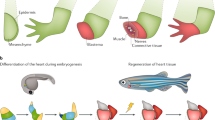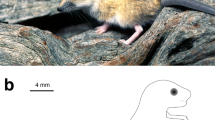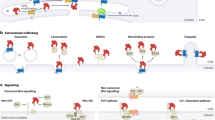Abstract
A number of unusual traits, including a remarkable capacity for wound healing and limb regeneration, make the axolotl an interesting animal model. The author provides an overview of axolotl care and use in biomedical research.
This is a preview of subscription content, access via your institution
Access options
Subscribe to this journal
We are sorry, but there is no personal subscription option available for your country.
Buy this article
- Purchase on Springer Link
- Instant access to full article PDF
Prices may be subject to local taxes which are calculated during checkout








Similar content being viewed by others
References
Smith, H.M. in Developmental Biology of the Axolotl (eds. Armstrong, J.B. & Malacinski, G.M.) 3–12 (Oxford University Press, New York, 1989).
Griffiths, R.A., Graue, V. & Bride, I.G. The axolotls of Lake Xochimilco: the evolution of a conservation program. Axolotl Newslett. 30, 12–18 (2003).
Muneoka, K., Bryant, S.V. & Gardiner, D.M. in Developmental Biology of the Axolotl (eds. Armstrong, J.B. & Malacinski, G.M.) 143–156 (Oxford University Press, New York, 1989).
Chernoff, A.G. & Stocum, D.L. Developmental aspects of spinal cord and limb regeneration. Dev. Growth Differ. 37(2), 133–147 (1995).
Nye, H.L., Cameron, J.A., Chernoff, E.A. & Stocum, D.L. Regeneration of the urodele limb: a review. Dev. Dynam. 226(2), 280–294 (2003).
Tassava, R.A. & Olsen-Winner, C.L. Responses to amputation of denervated Ambystoma limbs containing aneurogenic limb grafts. J. Exp. Zool. 297A(1), 64–79 (2002).
Barlow, L.A. Specification of pharyngeal endoderm is dependent on early signals from axial mesoderm. Development 128(22), 4573–4583 (2001).
Drawbridge, J., Meighan, C.M., Lumpkins, R. & Kite, M.E. Pronephric duct extension in amphibian embryos: migration and other mechanisms. Dev. Dynam. 226, 1–11 (2003).
Shook, D.R., Majer, C. & Keller, R. Urodeles remove mesoderm from the superficial layer by subduction through a bilateral primitive streak. Dev. Biol. 248(2), 220–239 (2002).
Borland, S., Crawford, K. & Brand, V. Setting the stage: developmental biology in the pre-college classroom. Int. J. Dev. Biol. 47(2–3), 85–91 (2003).
Voss, S.R. & Shaffer, H.B. Evolutionary genetics of metamorphic failure using wild-caught vs. laboratory axolotls (Ambystoma mexicanum). Mol. Ecol. 9(9), 1401–1407 (2000).
Voss, S.R. & Shaffer, H.B. Adaptive evolution via a major gene effect: paedomorphosis in the mexican axolotl. Proc. Natl. Acad. Sci. USA 94(25), 14185–14189 (1997).
Asashima, M., Malacinski, G.M. & Smith, S.C. in Developmental Biology of the Axolotl (eds. Armstrong, J.B. & Malacinski, G.M.) 255–263 (Oxford University Press, New York, 1989).
Bordzilovskaya, N.P. & Dettlaff, T.A. Table of stages of the normal development of axolotl embryos and the prognostication of timing of successive developmental stages at various temperatures. Axolotl Newslett. 7, 2–22 (1979).
Duhon, S. The I.U. Axolotl Colony's Short Guide to the Care and Feeding of Axolotls: an overview of the methods used at the Indiana University Axolotl Colony. Axolotl Newslett. 17, 15–18 (1988).
Carpenter, J.W., Ruppier, D.J. & Mashima, T.Y. Exotic Animal Formulary 2nd Edn. 25 (W.B. Saunders Co., Philadelphia, 2001).
FishDoc. Malachite green and formalin: a good general-purpose anti-parasite treatment. http://www.fishdoc.co.uk/treatments/malachite.htm.
Frye, F.L. & Williams, D.L. Self-Assessment Color Review of Reptiles and Amphibians 19–20 (Iowa State University Press, Ames, IA, 1995).
Borland, S. Practical axolotl. Axolotl Newslett. 28, 17–21 (2000).
Davidson, E.W., Jancovich, J.K., Borland, S., Newberry, M. & Gresens, J. What's Your Diagnosis? Dermal lesions, hemorrhage, and limb swelling in laboratory axolotls. Lab Anim. (NY) 32(3), 23–25 (2003).
Humphrey, R.R. The Axolotl Colony at Indiana University. Axolotl Newslett. 1, 3–8 (1979).
Keller, R.E., Loftberg, J. & Spieth, J. Neural crest cell behavior in white and dark embryos of Ambystoma mexicanum: epidermal inhibition of pigment cell migration in the white axolotl. Dev. Biol. 89(1), 179–195 (1982).
Frost-Mason, S.K. & Mason, K.A. What insights into vertebrate pigmentation has the axolotl model system provided? Int. J. Dev. Biol. 40(4), 685–693 (1996).
Frost, S.K. in Developmental Biology of the Axolotl (eds. Armstrong, J.B. & Malacinski, G.M.) 119–131 (Oxford University Press, New York, 1989).
Armstrong, J.B. The axolotl mutants. Dev. Genet. 6, 1–25 (1985).
Humphrey, R.R. & Bagnara, J.T. A color variant in the Mexican axolotl. J. Hered. 58(5), 251–256 (1967).
Humphrey, R.R. Albino axolotls from an albino tiger salamander through hybridization. J. Hered. 58(3), 95–101 (1967).
Acknowledgements
All the work done by the IUAC is possible because of the generous support of the National Science Foundation (current award number DBI-0234425). In addition, the author would like to thank Axolotl Colony Director George Malacinski and the two anonymous reviewers for their insightful comments on the first drafts of this paper. Extra thanks to IUAC Curator Rachel Boyd for her photography assistance.
Author information
Authors and Affiliations
Corresponding author
Rights and permissions
About this article
Cite this article
Gresens, J. An Introduction to the Mexican Axolotl (Ambystoma mexicanum). Lab Anim 33, 41–47 (2004). https://doi.org/10.1038/laban1004-41
Received:
Accepted:
Issue Date:
DOI: https://doi.org/10.1038/laban1004-41



